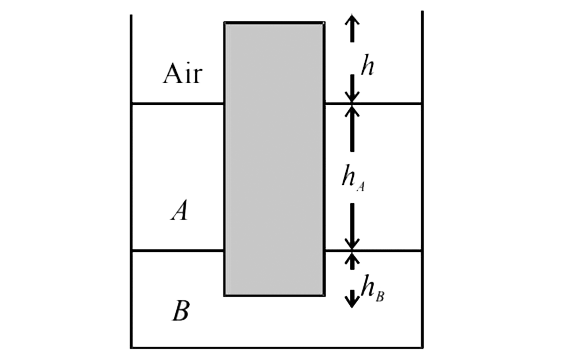A uniform solid cylinder of density 0.8g/cm3 floats in equilibrium in a combination of two non-mixing liquids A and B with its axis vertical.
The densities of the liquids A and B are 0.7g/cm3 and 1.2g/cm3, respectively. The height of liquid A is hA=1.2cm. The length of the part of the cylinder immersed in liquid B is hB=0.8cm.

(a) Find the total force exerted by liquid A on the cylinder.
(b) Find h, the length of the part of the cylinder in air.
(c) The cylinder is depressed in such a way that its top surface is just below the upper surface of liquid A and is then released. Find the acceleration of the cylinder immediately after it is released.
The correct Answer is:(i) 0 (ii) 0.25 (iii) 106
(i) 0 (ii) 0.25 (iii) 106
(i) Liquid A is applying the hydrostatic force on cylinder from all the sides. So, net force is zero.
(ii) In equilibrium weight of cylinder = Net upthrust on the cylinder let s be the area of cross-section of the cylinder, then weight =(s)(h+hA+hB)ρcylinderg and upthrust on the cylinder= upthrust due to liquid A + upthrust due to liquid B = shAρAg+shBρBg
Equation these two, s(h+hA+hB)ρcylinderg=sg(hAρA+hBρB)
or (h+hA+hB)ρcylinder=hAρA+hBρB
Substituting,
hA=1.2cm,hB=0.8cmandρA=0.7g/cm3,ρB=1.2g/cm3andρcylinder=0.8g/cm3
In the above equation , we get h = 0.25 cm
(iii) Net upward force = extra upthrust =shρBg
∴ Net acceleration a=forcemass of cylinder
or a=shρBgs(h+hA+hB)ρcylinderora=shρBg(h+hA+hB)ρcylinder
Substituting the values of h,hAhB,ρBandρcylinder, We get a=g6 (upwards )

Similar Questions
A jar contains two immiscible liquids A and B with a coin at its bottom. The depths of liquid A and liquid B are 6 cm and 8 cm, respectively. If the apparent depth of the coin is 9 cm and refractive index of liquid A is 1.5, what is the refractive index of liquid B?
View SolutionA column of water 40cm height supports a 30cm column of an unknown liquid . What is the density of the liquid ?
View Solution
Knowledge Check
Choose the most appropriate options.
Argon crystallises in fcc arrangement and the density of solid and liquid Ar is 159g/cm3and1.42g/cm3, respectively. The percentage of empty space in liquid Ar isA34.84%B43.8%C23.4%D21.6%The density of a liquid at 100∘C is 8.0g/cm3 and at 0∘C is 8.4g/cm3, the coefficient of cubical expansion of the liquid is
A10−4/∘CB5×10−4/∘CC8×10−4/∘CD4×10−4/∘CAn object of relative density 0 . 75 is floating in a liquid with 500cm3 of the object inside the liquid . Find the total volume of the object, if the relative density of liquid is 1 . 0 2
A60cm3B680cm3C700cm3D740cm3
Two miscible liquids of densities 1.2gm/cm and 1.4gm/cm aer mixed with a proportion ratio of their volumes equal to 2.5: what is the density of redulting liquid?
View SolutionTwo identical tanks contain water and a liquid of density 0.8gcm−3. Pressure exerted by the liquid is equal to the pressure due to water column of 50 cm. Find the height of the liquid column in the tank ?
View SolutionTwo immiscible of densities 2.5g/cm3 and 0.8g/cm3 are taken in the ratio of their masses as 2:3 respectively find the average density of the liquid conbination.
View SolutionTwo identical containers A and B are filled with two different liquids of equal masses. The level of the liquid in container A is found to be one-fourth of the level of the liquid in container B. What is the ratio of thedensity of two liquids? If the density of he liquid in the container A is 2 " g "cm−3, then find the density of the mixture of the two liquids.
View SolutionWhen 100 drops of a liquid P is added into a liquid Q the volume of the liquid in the container which is initially filled with liquid Q doubled. Determined density of the mixture if density of the liquids P and Q are 1.5 g cm ^(-3) and 1.3 g cm^(-3), respectively
View Solution
